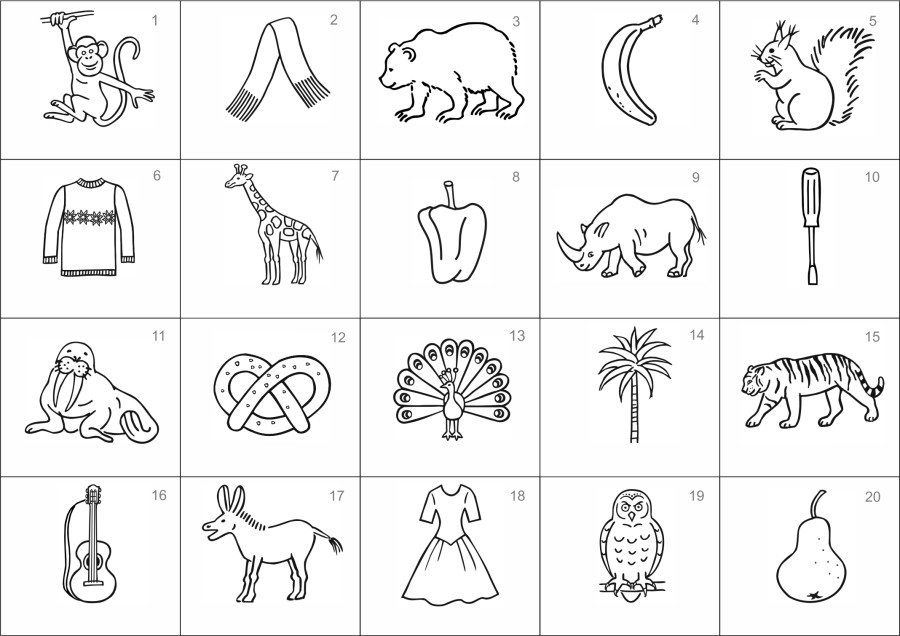PICture Naming and Immediate Recall (PICNIR)
The PICture Naming and Immediate Recall (PICNIR) test combines the naming and recall into one instrument using a carefully selected set of 20 black and white drawings to simultaneously assess several cognitive functions (long-term semantic and short-term episodic memory and written language) in just five minutes.
Three versions are available: the door one, the hedgehog one and the monkey one according to the first picture of the set.
The administration and scoring of PICNIR by trained staff are simple and time-efficient.
The brief PICNIR test is cognitively demanding due to the divided attention associated with the naming and simultaneous remembering pictures in the first phase and having to recall the names of as many pictures as possible in the second phase. The high demand was validated in cognitively healthy and mildly impaired individuals and showed that the hedgehog version of the PICNIR was comparable to the Montreal Cognitive Assessment.
The PICNIR test can be easily used in various clinical situations for identifying very mild cognitive impairment. Due to the visual nature of the test, it can be used in any population in which the pictures are generally recognizable.

Educational video on the PICNIR test
Administration nad scoring of the hedgehog version of the PICNIR by his author
The PICture Naming and Immediate Recall (PICNIR) is an innovative and valid test that offers many advantages for busy clinicians and other professionals. The PICNIR is based on a new and unique testing paradigm. It consists of two parts. The first task is to write down the names of 20 black-and-white pictures for an evaluation of long-term semantic memory and language. The second task includes an immediate recall and writing as many picture names as possible in one minute.
Its distinctive features include a neatly organized test format that fits on a single page. Additionally, it is ultra-brief and straightforward, almost entirely self-administered, i.e., the test requires minimum input from or interaction with the test administrator. The PICNIR test uses original, easily recognized pictures and is quick and easy to score. It is an easily administered, but cognitively demanding test that can detect even very mild cognitive impairment.
The PICNIR test has the potential to become an ultra-brief and universal cognitive test useful for cognitive impairment, dementia, and other purposes. The PICNIR can be easily adapted to other cultures and languages due to its picture basis, implemented under a variety of conditions and settings, and is suitable for everyday clinical practice and research, or for use in widespread or population screening, or as a pre-screening tool in clinical trials. Many clinicians and other professionals can benefit from the PICNIR since simple and quick administration and scoring are feasible in the cognitive fields of neurology, psychiatry, and geriatrics, as well as in primary and social care, peri-operative surgery, anesthesiology, pharmacy, and other medical disciplines. The PICNIR also has the potential for assessing cognitive functions in telemedicine health.
Literature to the PICNIR test
- Bartos A, Diondet S. Sensitive written hedgehog PICture Naming and Immediate Recall (PICNIR) as a valid and brief test of semantic and short-term episodic memory for very mild cognitive impairment. J Alzheimers Dis. 2024;102(2):396-410. https://doi.org/10.1177/13872877241289385
- Bartos A. ALBA and PICNIR tests used for the simultaneous examination of two patients with dementia and their adult children. Cesk Slov Neurol N 2021; 84/ 117(6): 583–586
in Czech - it can be translated using e.g. Google Translator or Deeple.com: - Bartoš A. Pamatujte na POBAV - krátký test pojmenování obrázků a jejich vybavení sloužící ke včasnému záchytu kognitivních poruch. Neurologie pro praxi. 2018, Supplementum, 19, 5-14. ISSN 1213-1814.
- Bartoš A. Netestuj, ale POBAV: písemné záměrné Pojmenování OBrázků A jejich Vybavení jako krátká kognitivní zkouška. Cesk Slov Neurol N 2016; 2016; 79/112(6), 671-679
